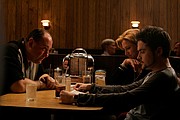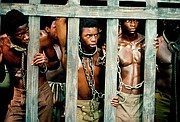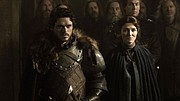1/16/2024

By Scottie Andrew, CNN
(CNN) — And they say TV’s not good for you.
It was through a television screen that most people witnessed the 1969 lunar landing and Martin Luther King Jr.’s “I Have a Dream” speech. Together, viewers saw firsts like Mister Rogers sharing a foot bath with his Black policeman neighbor, Officer Clemmons, on a hot day. They listened as Whitney Houston’s transcendent voice soared through “The Star-Spangled Banner” during her iconic Super Bowl performance in 1991.
These and more indelible moments appear on the Television Academy’s new list of the 75 most impactful moments in TV history, spanning introductions, endings and history-making events.
Released in conjunction with the 75th Annual Emmy Awards, the list includes moments from every decade, from the premiere of “Meet the Press” in 1947 to an emotional episode of “The Last of Us” that aired just last year.
As we know, TV isn’t just a medium for entertainment, and many of the moments on these list speak to larger chapters in our history. The response to the footage of George Floyd’s murder, which in 2020 inspired activists to protest anti-Black racism and police violence, showed how challenging and influential the medium can be.
TV can be a point of connection, too, inspiring conversations about a silly gag on “I Love Lucy” at the office water cooler or gobsmacked tweets about the shocking ending to an episode of “Game of Thrones.”
Although our relationship with television and its technology has changed drastically over the last few decades, this list is proof that the medium continues to engage and inspire us.
Moments of history in the making
With the advent of national broadcast news shows in the 1950s, viewers no longer had to wait until the next morning’s newspaper dropped on their doorstep to watch history unfold. The evening news in the 20th century offered a window to world-altering events: In 1969, an estimated 650 million people watched a blurry image on their TV sets as Neil Armstrong walked on the moon.
Live news coverage has shepherded viewers through unimaginable tragedies like the September 11th terrorist attacks in 2001 and the Space Shuttle Challenger explosion in 1986. In 1994 the nation watched, rapt, in real time while police chased NFL legend O.J. Simpson in a white Ford Bronco — the closest one could get back then to the immediacy of today’s social media.
TV also has helped viewers make sense of the news as it happens, as an emotional Walter Cronkite did in 1963 when he announced the assassination of President John F. Kennedy. Even now, with the world at our fingertips, people still turned anxious eyes to their television sets on January 6th, 2021, as protests at the US Capitol turned into an insurrection.
These were the historic moments on the Television Academy’s list:
The moon landing, 1969
9/11 coverage, 2001
John F. Kennedy’s death announced by Walter Cronkite, 1963
Martin Luther King, Jr.’s “I Have a Dream” speech
CNN’s coverage of Space Shuttle Challenger explosion, 1986
O.J. Simpson Bronco car chase, 1994
First Kennedy-Nixon presidential debate, 1960
Footage of George Floyd’s murder, 2020
January 6 insurrection, 2021
President-elect Barack Obama’s Election Night speech, 2008
Footage of Rodney King’s beating at the hands of police, 1991
O.J. Simpson trial verdict airs, 1995
Princess Diana’s funeral, 1997
Queen Elizabeth II’s coronation, 1953
Los Angeles riots in wake of Rodney King verdict, 1992
Groundbreaking ideas
TV programs have also served to challenge audiences and interrogate social norms. In 1969, beloved children’s TV host Mister Rogers invited his neighbor Officer Clemmons, a Black police officer, to cool his feet in a pool on a hot day — a simple but quietly revolutionary act during a time when many pools across the country still banned Black Americans from swimming.
“Star Trek’s” passionate 1968 smooch between William Shatner’s Captain Kirk and Nichelle Nichols’ Uhura wasn’t just a huge moment for Trekkies. It was also one of the first interracial kisses on TV, and caused such a response that Nichols said she received more fan mail for the episode — most of it positive — than for any other during her stint on the show.
What happens on TV happens in the real world, too. The same month Ellen DeGeneres’ character on her eponymous ‘90s sitcom came out as gay, the comedian came out on a Time magazine cover. DeGeneres’s admission was praised by LGBTQ rights groups, but her show was canceled a year later after ratings declined and network executives asked her not to include “gay content” in every episode. She returned to TV in 2003 to host her own daytime talk show, which ended in 2022.
And media was flipped on its head when MTV debuted in 1981 with the Buggles’ “Video Killed the Radio Star,” kicking off its decades-long reign as the TV destination for young pop culture enthusiasts.
Here are the top moments that changed our culture:
Mister Rogers dips feet in a pool with Officer Clemmons, 1969
MTV premieres with its first music video – “Video Killed the Radio Star,” 1981
“Ellen” comes out, 1997
“All in the Family” – Sammy Davis, Jr. kisses Archie on the cheek, 1972
“I Love Lucy” – Lucy Ricardo gives birth to Little Ricky (and Lucille Ball gets a C-section offscreen), 1953
Live Aid concert features major artists, most famously Queen, in fundraising efforts for Ethiopian famine victims, 1985
“Maude” – Bea Arthur’s Maude decides she wants an abortion, 1972
Kelly Clarkson wins the first season of “American Idol,” 2002
“Star Trek” – Kirk and Uhura kiss, 1968
Must-see premieres
These are the series that changed the landscape of television upon their debuts – and occasionally helped change minds.
“Roots,” recently named one of the 10 greatest TV series of all time by Variety, was a landmark series for its unflinching depiction of slavery, racism and Black life in the US from the 19th century to its 1970s present. It aired over eight nights in 1977, signaling to viewers that “Roots” was a must-see event. Matt Zoller Seitz wrote for Vulture that “Roots” amounted to “the first prolonged instance of not merely being asked to identify with cultural experiences that were alien to (White viewers), but to actually feel them.”
When “Sesame Street” debuted in 1969, it was one of the first TV series that aimed to educate and entertain child viewers from all backgrounds — and also happened to star a diverse cast of humans and Muppets. The stalwart series is still airing today, along with “Saturday Night Live” and “The Simpsons” — two other long-running programs that have influenced the current structures of comedy, sitcoms and American TV.
“Roots” premieres, introducing viewers to Kunta Kinte (Levar Burton), 1977
“Saturday Night Live” premieres, hosted by George Carlin, 1975
“Sesame Street” debuts with Gordon touring the neighborhood, 1969
“60 Minutes” debuts, 1968
“Breaking Bad” pilot introduces Walter White, fleeing police, recording a video for his family in his underwear, 2008
“All in the Family” – viewers meet the working-class Bunker family, 1971
“Schoolhouse Rock!” – The “Conjunction Junction” song introduces young viewers to “and,” “but” and “or” as boxcars at a train station, 1973
“The Simpsons” – Bart and Homer get a family dog named Santa’s Little Helper, 1989
CNN debuts, with an intro from Ted Turner, as the first 24-hour news channel, 1980
“The Golden Girls” – Sophia moves in with daughter Dorothy and her roommates Blanche and Rose, 1985
“The Twilight Zone” - A man is seemingly alone in a small town until it’s revealed he’s an astronaut hallucinating, 1959
“The Nat King Cole Show” - The famed musician became the most prominent Black celebrity to helm a TV show, though it ran for only a season, 1957
“Lost” - Oceanic Airlines Flight 815 crashes on a mysterious island, leaving its survivors to fight for their lives, 2004
“Game of Thrones” – The Night’s Watch meet their first White Walker, 2011
“The French Chef” – Julia Child makes boeuf bourguignon, 1963
“The Real World” - MTV’s reality show about a diverse group of young people sharing an apartment in New York premieres with a Southern dancer, a hip-hop performer, a bisexual artist, a model recovering from steroid use and a poet-activist, 1992.
“Julia” – Diahann Carroll’s single mother, Julia, moves to the suburbs with her young son, 1968.
“Will and Grace” - Will, Grace’s gay best friend, tells her that her impending marriage is a mistake, 1998
“Meet the Press” – The news commentary program debuts with guest James Farley, former Postmaster General and Democratic National Committee Chairman, 1947
Iconic goodbyes
When a beloved series signs off, it’s a huge television event. Before the streaming era, series finales were sometimes bigger than the Super Bowl, drawing millions of viewers eager to see how a series concludes.
The frequently silly “M*ASH” struck a bittersweet chord in its finale, reminding audiences of the mental toll of war, even during peacetime. It’s still the most-watched series finale of all time, with over 106 million viewers glued to their screens to witness Hawkeye bid his comrades goodbye.
One of the most acclaimed series of all time also had one of the most controversial endings. The tense final minutes of the 2007 series finale of “The Sopranos” ended with an abrupt cut to black so unexpected some viewers feared their cable service had cut out. Seventeen years later, fans are still dissecting and debating what happened to the Sopranos family in those last crucial moments.
8.” M*ASH” series finale, 1983
“Newhart” finale reveals that the entire series was just a dream of Dr. Robert Hartley, who Bob Newhart played in the earlier “Bob Newhart Show,” 1990
“The Sopranos” finale inspires confusion with its mysterious finale full of loose ends, 2007
“Six Feet Under” ends by showing how every main character lives – and dies, 2005
“Mary Tyler Moore Show” - Mary turns out the lights in the newsroom one last time, 1977
“Friends” – Everyone says goodbye in Monica and Rachel’s apartment for the last time, 2004
“Cheers” – Ted Danson’s Sam quips “he’s the luckiest son of a b*h on Earth,” 1993
“The Tonight Show” – Bette Midler sings a fond farewell to host Johnny Carson for his final episode, 1992
Talked-about drama
There’s a reason “Who shot J.R.?” is still in the pop culture parlance. People remember where they were when they succumbed to Beatlemania on “The Ed Sullivan Show,” or when a shocking shooting went down on “Dallas,” or when they were subjected to the heartbreaking horror of the Red Wedding on “Game of Thrones.” These are the the TV beats you just couldn’t miss, lest you be left out of the conversation the next day.
Nowadays, those water cooler conversations are mostly happening online as the show airs. But these classic TV moments that stirred audiences when they first aired are still resonant and frequently referenced in contemporary culture.
For all she has done in her career, one of Oprah’s most immortal moments will always be a 2004 surprise giveaway on her show, which peaked with her bellowing, “You get a car! And you get a car!” to members of her screaming audience.
Although we may watch in the privacy of our own homes, these revelatory moments show TV’s power as a meeting place of sorts, where conversations begin and connections are made.
“The Ed Sullivan Show” - The Beatles make their US TV debut, 1964
“The Ed Sullivan Show” - Elvis performs “Hound Dog,” 1956
“Charlie Brown Christmas” – Linus shares with Charlie Brown the true meaning of Christmas, 1965
“The Carol Burnett Show” airs a “Gone with the Wind” parody, 1976
“I Love Lucy” – Lucy gets drunk shooting commercials for a liquor-filled vitamin, 1952
“Dallas” – J.R. is shot, 1980
“The Mary Tyler Moore Show” – Mary can’t stop laughing during funeral of Chuckles the Clown, 1975
“M*ASH” – Radar announces that Col. Blake’s plane was shot down, and there were no survivors, 1975
“Seinfeld” - Jerry and the gang face off against the “Soup Nazi,” 1995
Academy Awards – Will Smith slaps Chris Rock, 2022
“The Twilight Zone” – bibliophile Harry Bemis is the last man on Earth, and finally gets to spend uninterrupted time with his books – until he breaks his glasses, 1959
“Roots” – Kunta Kinte is repeatedly whipped until he renames himself Toby, 1977
“Merry Melodies,” “What’s Opera, Doc?” segment in which Elmer Fudd (as Siegfried) carries Bugs Bunny (as Brunhilde) to Valhalla, 1957
“Thriller” – Michael Jackson’s video airs on MTV, 1982
“Oprah” – Host Oprah Winfrey gives everyone in her audience a new Pontiac, 2004
“Game of Thrones” – Red Wedding episode. Robb Stark is murdered along with his new wife, mother and supporters, 2013
“Sesame Street” – In “Goodbye, Mr. Hooper,” the cast teaches Big Bird (and viewers at home) about grief after the actor playing Mr. Hooper died offscreen, 1983
The ending of “The Day After,” a TV film about the nuclear apocalypse, 1983
“The Last of Us” – Lovers Bill and Frank die by suicide after fending off fungus zombies and would-be looters for over two decades, 2023
Super Bowl XXXVIII Halftime Show – Justin Timberlake exposes Janet Jackson’s breast during their performance, 2004
“General Hospital” – Luke and Laura get married, 1981
Super Bowl XXV pregame – Whitney Houston sings the National Anthem, 1991
“Peter Pan” – the Darling children learn to fly in the TV musical, 1955
“Walt Disney’s Disneyland” – Disney introduces his new theme park, 1954



